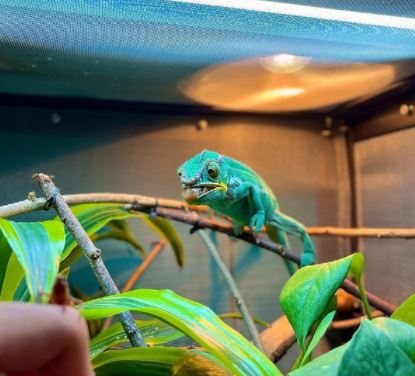How do chameleons change color
How do chameleons change color: The world of reptiles is home to a myriad of captivating creatures, but few can rival the enigmatic chameleon. These fascinating reptiles are renowned for their incredible ability to change color, a characteristic that has captivated the attention and imagination of scientists and nature lovers alike. From ancient folklore to modern-day scientific research, the chameleon’s color-changing prowess has garnered widespread fascination and admiration.
Definition and Introduction to Chameleons
Chameleons belong to the family Chamaeleonidae, consisting of approximately 200 species distributed across various regions of Africa, Madagascar, Europe, and Asia. These remarkable creatures possess unique characteristics that set them apart from other reptiles.
With their distinctive physical attributes such as independently rotating eyes, zygodactylous feet (two toes pointing forward and two backward), prehensile tails, and elongated bodies, chameleons have evolved into highly specialized predators. Their most remarkable feature is undoubtedly their ability to change color almost instantaneously.
This extraordinary phenomenon sets them apart from all other vertebrates on our planet. While popular belief suggests that chameleons change color as a way to camouflage themselves in response to their environment, this notion only scratches the surface of their complex color-changing adaptations.
Fascination with Chameleon Color-Changing Ability
 The awe-inspiring ability of chameleons to morph into a stunning kaleidoscope of colors has captivated human fascination for centuries. In ancient civilizations like Egypt and Greece, chameleons were often associated with mythical powers due to their otherworldly appearance and seemingly magical transformation abilities.
The awe-inspiring ability of chameleons to morph into a stunning kaleidoscope of colors has captivated human fascination for centuries. In ancient civilizations like Egypt and Greece, chameleons were often associated with mythical powers due to their otherworldly appearance and seemingly magical transformation abilities.
Even in modern times, this mesmerizing attribute continues to capture our imagination. Scientists have dedicated extensive research efforts towards unraveling the intricate mechanisms behind chameleon color changing.
Not only is it an essential aspect of their survival, aiding in camouflage and communication, but it has also inspired advancements in technology, such as the development of color-changing materials and adaptive camouflage for military purposes. Understanding the processes that drive chameleon color change not only deepens our appreciation for their natural beauty but also offers insights into the fascinating world of animal adaptation.
In this article, we will delve into the science behind chameleon color change, explore the various environmental factors that influence their coloration, and uncover the emotional responses reflected through their astonishing ability to transform hues at will. Stay tuned to embark on a captivating journey into the wondrous realm of chameleons and unravel the secrets behind their astounding color-changing abilities.
The Science Behind Chameleon Color Change
Chameleons are renowned for their remarkable ability to change color, allowing them to blend seamlessly into their environment or communicate with other chameleons. This fascinating phenomenon is made possible by specialized cells called chromatophores, which play a vital role in the intricate process of color change.
Chromatophores: The Key to Color Change
Chromatophores are pigment-containing cells found in the outermost layer of a chameleon’s skin called the dermis. These cells contain pigments that determine the colors visible on a chameleon’s body. The primary function of chromatophores is to expand or contract, altering the amount and arrangement of pigments and thus changing the coloration of the skin.
There are three main types of chromatophores found in chameleons: melanophores, xanthophores, and erythrophores. Each type contains specific pigments responsible for creating different hues and shades.
Pigment Cells: Melanophores, Xanthophores, and Erythrophores
Melanophoress: Melanophores are responsible for producing dark colors such as brown and black on a chameleon’s skin. These cells contain pigment-filled granules called melanin.
Melanin serves as a natural sunscreen against harmful ultraviolet (UV) radiation from sunlight while also providing camouflage benefits. When exposed to intense light or higher temperatures, melanin production increases within melanophore cells, resulting in darker skin tones.
Xanthophoress: Xanthophoress are responsible for displaying vibrant yellow colors in chameleons’ skin.
These cells contain carotenoid pigments—a group of naturally occurring compounds found in plants. Xanthophores typically distribute carotenoids throughout the skin, creating a yellow coloration.
Interestingly, factors such as diet and overall health can influence the intensity of yellow coloration in chameleons, as their ability to obtain carotenoids from food plays a crucial role. Erythrophoress:
Erythrophoress are responsible for vibrant reds and oranges observed in some chameleons. These cells contain pteridines, which are pigments that interact with other pigments already present in the chromatophores to create these striking hues.
The presence of pteridines within erythrophore cells allows for an impressive range of red and orange color variations among different chameleon species. A chameleon’s ability to change color is a complex process driven by specialized pigment-containing cells called chromatophores.
Melanophores produce dark colors like brown and black through the production of melanin. Xanthophores generate vibrant yellows using carotenoid pigments influenced by factors such as diet and health.
Erythrophores are responsible for vivid reds and oranges due to the presence of pteridines that interact with other pigments within chromatophores. Understanding these mechanisms sheds light on the intricacies behind chameleon color change and showcases nature’s incredible adaptability and diversity.

Environmental Factors Influencing Color Change
Temperature Regulation as a Primary Driver
One of the primary reasons chameleons change color is to regulate their body temperature. As ectothermic creatures, they rely on external heat sources to warm their bodies and maintain optimal physiological functioning. By altering their skin coloration, chameleons can effectively manage their body temperature in different environments.
In cooler conditions or during the night when temperatures drop, chameleons adapt by adopting darker colors. Dark pigments, predominantly found in melanophores (pigment cells responsible for brown and black colors), absorb more light and thus heat up faster.
This allows the chameleon’s body to remain warm by increasing heat absorption from sunlight or other external sources. Conversely, when temperatures rise or under intense sunlight exposure, chameleons opt for lighter colors that reflect more light.
Lighter pigments present in specialized cells called iridophores and guanophores scatter and reflect solar radiation away from the skin surface. This behavior assists the reptile in preventing overheating and maintaining a comfortable body temperature.
Light Intensity and Wavelength Effects on Coloration
In addition to temperature regulation, light intensity and wavelength also play a significant role in influencing chameleon coloration. Chameleons possess specialized photoreceptor cells called cones that enable them to perceive different wavelengths of light.
Ultraviolet (UV) light has a profound impact on chameleon coloration as it is invisible to human eyes but highly visible to these reptiles. Many species possess UV-sensitive cones that detect UV wavelengths reflected off potential mates or rivals during territorial displays.
The interaction between visible light wavelengths and pigment cells results in fascinating color transformations. Different pigments absorb or reflect specific wavelengths, leading to the chameleon’s vibrant display of colors.
For instance, when light strikes xanthophores (yellow pigment cells), they absorb shorter blue wavelengths and reflect longer yellow wavelengths, resulting in the reptile’s characteristic yellow hue. Moreover, infrared light plays a crucial role in thermoregulation for chameleons.
As warm-blooded prey emits infrared radiation, chameleons can detect and track them using specialized organs called pit organs. This ability aids them in temperature regulation as well as hunting.
Achieving a Harmonious Blend: Absorption, Reflection, or Transmission of Different Wavelengths
 The intricate interplay between pigmentation and environmental factors allows chameleons to achieve an impressive array of color combinations. By selectively absorbing, reflecting, or transmitting different wavelengths of light through their pigments and specialized cells, these reptiles create visually stunning displays. For example, when a chameleon wants to blend into its surroundings for camouflage purposes or evade predators, it can alter its skin coloration to match the colors prevalent in its environment.
The intricate interplay between pigmentation and environmental factors allows chameleons to achieve an impressive array of color combinations. By selectively absorbing, reflecting, or transmitting different wavelengths of light through their pigments and specialized cells, these reptiles create visually stunning displays. For example, when a chameleon wants to blend into its surroundings for camouflage purposes or evade predators, it can alter its skin coloration to match the colors prevalent in its environment.
By absorbing specific wavelengths similar to those present in nearby objects and reflecting others that closely resemble background hues, the chameleon seamlessly merges with its surroundings. In addition to camouflage and temperature regulation benefits conferred by color change, this ability also serves important social functions.
Vibrant displays of colors during courtship rituals help attract potential mates or establish dominance hierarchies among competitors within a species. Environmental factors significantly impact how chameleons change color.
Temperature regulation is a primary driver behind their color adaptation mechanism; dark colors absorb heat for warmth during cooler periods while lighter colors reflect heat under intense sunlight. Moreover, light intensity and wavelength exert profound effects on coloration by influencing pigment cell activity.
UV light detection aids in communication and mate selection for these reptiles, while visible light and infrared play crucial roles in achieving camouflage and thermal regulation. The astonishing ability of chameleons to manipulate their pigmentation and harmoniously blend with their surroundings or express emotions through vibrant colors is a testament to the complexity and beauty of nature’s design.
To sum up how do chameleons change color
The remarkable ability of chameleons to change their colors not only serves practical purposes like camouflage but also acts as a visual language for communication and self-expression. Through intricate displays of vibrant hues or subtle shifts in pigmentation, these reptiles convey emotional states such as courtship, fear, stress, and dominance.
The study of chameleon color change provides us with an extraordinary glimpse into the complex world of animal communication. As we delve deeper into the mechanisms behind chameleon coloration and its link to emotions, we gain a greater appreciation for the beauty and intricacy of nature’s design.
This phenomenon reminds us that even in the animal kingdom, where survival is paramount, there exists a wealth of fascinating expressions that enrich our understanding of life on Earth. Let us marvel at the wonders around us and continue to explore the captivating realm where science meets artistry.
Further Reading:
- Best Turtle Substrate For Your Pet Tank
- Coconut substrate for chameleons
- Caught my Chameleon eating moss


